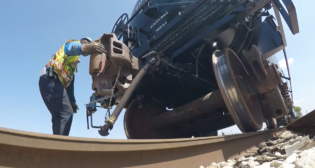
Laboratory Testing of Reconditioned Bearings
Written by Dustin Clasby, Senior Engineer, Transportation Technology Center, Inc.TTCI R&D, RAILWAY AGE NOVEMBER 2021 ISSUE: Roller bearing reconditioning is a common practice in the railroad industry, with 90% of the bearings in revenue service having been through the reconditioning process. Transportation Technology Center, Inc. (TTCI) is collecting test data on the performance and service life of bearings following reconditioning repairs. The testing for this research project consisted of two phases.
Phase 1, now complete, focused on bearing performance. The second, currently under way, concentrates on service life.
In Phase 1, the performance of repaired bearings was assessed by examining the operational characteristics of the bearings both before and after the repairs. In Phase 2, service life research will explore how long repairs could be expected to last and any repair features that may extend service life.
The method employed in the first phase was a comparison of bearing performance before and after reconditioning repairs. The test was conducted using approximately 10,000-mile runs on a bearing rig at the University of Texas Rio Grande Valley (UTRGV). These relatively short test runs allowed the bearings to reach a steady state in both the operating temperature and the vibration of the bearing.
There are many different bearing reconditioning repairs available for several types of defects. TTCI began its testing by focusing on bearings with raceway fatigue spalling—the most common type of defect per AAR roller bearing reports records.
The reconditioning process for spalls begins with a visual inspection of the raceway. If any defect is identified, and it is capable of being repaired according to AAR rules, the defect is ground with a handheld rotary tool to remove the stress points. The material removal leaves a cavity in the raceway. Figure 1 (below) shows an example of spalls before and after repairs. The performance test investigated whether the raceway cavities created during the spall repair process could cause bearing performance issues demonstrated by vibration or increased temperatures.
Spalled cups from 12 bearings were selected for testing. Each bearing cup was tested on the UTRGV test rig, repaired per AAR standards, and then re-tested on the rig. The performance of all 12 bearings before repair was deemed to be within normal operating thresholds. Because spalls that can be repaired are relatively small, it is not surprising that these spalled bearing cups exhibited normal temperature and vibration performance before reconditioning repairs.
The temperature and vibration measurements for the bearings were also within normal operating thresholds after the reconditioning repair. However, a spall developed on one of the cup raceways after running 8,700 miles post repair. The spall initiated near the stress-relief holes created during the repair process. The next research phase will explore the expected life cycle of reconditioned spall repairs and investigate the potential causes of re-developed spalls.
Overall, the results suggest that spall repairs made during the reconditioning process did not have a major effect on the short-term performance of the test bearings. Of the 12 bearing cups tested, all produced temperature and vibration signatures within the normal operational experience of the testing facility both before and after the reconditioning repairs. Five test bearings experienced more steady temperatures or lower operating temperatures after the reconditioning repairs. Ten of the bearings experienced a decrease in vibration levels after the reconditioning repairs.
Phase 2 of TTCI’s research will test the longevity of the reconditioning repairs to determine how long a spall repair could be expected to last in revenue service.



